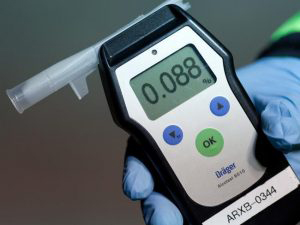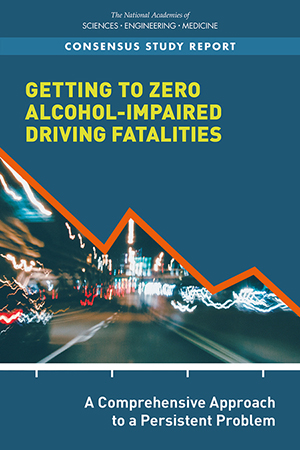Point .05 BAC Bills Stall
Influential advocacy groups MADD and Advocates for Highway and Auto Safety enter the fight.
 Bills in California and Oregon to lower the blood alcohol content (BAC) limit for driving under the influence (DUI) to 0.05% have stalled in the legislature. A similar bill in Michigan is still being deliberated. More encouragingly, the advocacy and public safety groups pushing for this life-saving limit have been joined by Mothers Against Drunk Driving (MADD), one of the strongest anti-DUI voices in the country, and the D.C.-based Advocates for Highway and Auto Safety, promising these issues will not go away quietly.
Bills in California and Oregon to lower the blood alcohol content (BAC) limit for driving under the influence (DUI) to 0.05% have stalled in the legislature. A similar bill in Michigan is still being deliberated. More encouragingly, the advocacy and public safety groups pushing for this life-saving limit have been joined by Mothers Against Drunk Driving (MADD), one of the strongest anti-DUI voices in the country, and the D.C.-based Advocates for Highway and Auto Safety, promising these issues will not go away quietly.
Under the guidance of the Liam’s Life foundation, California State Senator Jerry Hill and Assembly Member Autumn Burke introduced AB 1713, a 0.05% BAC bill. However, that bill has failed to advance from committee, leaving it on ice at least until next year. Likewise, Oregon Senate Bill 7, introduced by Senate President Peter Courtney, will not move forward despite vocal support from the governor.
“These legislatures need to get their priorities in order,” said Michael Scippa, Public Affairs Director of Alcohol Justice. “Lower BAC limits are evidence-based and popular. Simply put, point 05 saves lives.”
Efforts to lower the DUI threshold have been evidence-tested throughout the developed world. As of 2015, 34 countries had BAC limits of 0.05% or less, including Australia, France, Germany, and Italy. All in all, 2.1 billion people live in countries with the lower DUI threshold, making the U.S. an exception with its 0.08% standard. That exception may be coming to an end, however. Already, the state of Utah has lowered its threshold for DUI to 0.05%, and in recent years, Washington, New York, and Hawaii have joined California, Oregon, and Michigan in considering a similar limit.
The law represents a simple and direct way to prevent alcohol-related deaths. Researchers estimate that a nationally adopted 0.05% BAC level for DUI would save 1,800 lives annually. The life-saving benefits do not simply accrue because of more arrests. Researchers looking at lowered BAC limits in other countries noticed a drop in fatalities at all BAC levels, not just between 0.05% and 0.08%. This suggests that, regardless of police action, drivers see the lower limit as a cue to not drive after drinking.
Recognizing the power of policies promoting the 0.05% BAC, MADD threw its support behind the California and Michigan efforts. “We want to do everything we can to stop these tragedies [of impaired driving deaths],” said MADD National Board Member Carol Leister in a prepared statement. “That’s why MADD made the decision this year to support any state that seeks to lower the BAC threshold to 0.05.”
Advocates for Highway and Auto Safety, meanwhile, placed a blistering op-ed in the Washington Times, criticizing industry complaints that lower BAC limits are unfair or mistargeted. "Measurable change comes from effective leadership implementing data-driven, research-backed countermeasures such as .05 percent blood alcohol concentration policy," the authors write. "Progress in the fight against drunk driving has been stalled for decades, and new, proven solutions are urgently needed."
MADD has also supported another bill from Sen. Hill of California, SB 545, strengthening the requirements that convicted DUI offenders install ignition interlock devices. Leister declared the law was “long overdue in California.” That bill is currently in front of the senate Appropriations Committee.
READ MORE about Liam’s Law and the fight for Point 05 in California
READ MORE about how Point 05 Saves Lives
Will California Save Lives with Point .05?
When it comes to fighting dangerous drivers, California is poised to join the developed world.
Intoxicated driving remains a major cause of death in California, having claimed at least 1120 lives in 2017. Now, the California legislature is considering a powerful law to rein in the chaos. Thanks to the work of dedicated activists and conscience-driven lawmakers, a landmark piece of legislation could set a 0.05% Blood Alcohol Content (BAC) as the legal limit for drivers. Currently, the legal limit is 0.08 BAC, and that little downwards tweak could save hundreds of lives.
The bill, AB 1713, authored by State Assemblymembers Autumn Burke and Heath Flora, would make California only the second state in the U.S. to lower the limit. Utah passed a 0.05 bill in 2017, which went into effect at the beginning of this year. But elsewhere in the world, a 0.05BAC is the standard. Countries like Australia, France, Germany, Israel, Spain, Taiwan and Turkey all adhere to this standard, while others like Japan, China, and Sweden, insist drivers have a BAC of 0.03 or lower.
Impetus for the bill derives in part from Liam’s Life, an organization started by Marcus Kowal and Mishel Eder in memory of their son, who was struck by an incapacitated driver in 2015. In their campaign’s tribute to Liam, Kowel and Eder note that “drunk driving is a completely preventable problem, yet it still continues to happen.” “Liam’s Law,” as the bill is nicknamed, has the potential to reduce fatal car crashes as much as 18%, according to international research.
As California deliberate Liam’s Law, Oregon also has a 0.05 BAC bill in front of the legislature. State Senate President Peter Courtney proposed the bill, noting that “this is a Mount Everest move. It’s doable, but it isn’t going to be easy. I’m going to fight like hell to make it happen.” The American Beverage Institute—one of Big Alcohol’s major domestic lobbies—has already objected to the bill, as they did in Utah. Chief among their objections is the fact that the majority of alcohol-related fatalities involved BACs of 0.15 percent or higher.
“We’ve dismissed ABI's nonsense before, and so did Utah” said Michael Scippa, Public Affairs Director of Alcohol Justice, “and it’s scientifically illiterate. We know that Point .05 Saves Lives! Denying that just to protect your profits is murderously ignorant.”
Both California and Oregon’s bills are currently in committee, and will be followed closely by Alcohol Justice.
READ MORE about how Point 05 Saves Lives.
National Academy of Sciences: For Safe Roads, We Need Point 05 BAC
 The time may have come for the United States to be dragged kicking and screaming into accepting .05 blood alcohol content (BAC) limits for DUI. Currently, every state in the U.S. has a .08 BAC, much higher than the .05 that is commonly enforced throughout much of the developed world. A new report from the National Academy of Sciences (NAS), the pre-eminent research council in the country, recommends we play catch up.
The time may have come for the United States to be dragged kicking and screaming into accepting .05 blood alcohol content (BAC) limits for DUI. Currently, every state in the U.S. has a .08 BAC, much higher than the .05 that is commonly enforced throughout much of the developed world. A new report from the National Academy of Sciences (NAS), the pre-eminent research council in the country, recommends we play catch up.
Alcohol-related crashes take the lives of an American every 49 minutes. In its new report, Getting to Zero Alcohol-Impaired Driving Fatalities: A Comprehensive Approach to a Persistent Problem, the NAS emphasizes that "these deaths are entirely preventable." The key, the authors stress, is to approach the problem at multiple steps in the process. This means simultaneously lowering the amount of alcohol the U.S. drinks as whole, reducing binging and other overconsumption, keeping incapacitated drinkers from getting behind the wheel, and preventing them from repeating the process once they have been caught.
Key among this is the lowered BAC. As the authors note, driving ability has already begun to degrade by the time BAC reaches 0.05%. At least one state-Utah-has accepted this as a reasonable strategy to reduce mortality. Other states may follow; Washington and Hawaii considered similar bills last year, and a 0.05 BAC bill introduced by Assemblyman Felix Ortiz is current before the New York State legislature.
"Thanks are due to Mr. Ortiz for taking this stand," said Michael Scippa, Director of Public Affairs for Alcohol Justice. "Lowering the BAC limit is evidence-based, reasonable, and accepted throughout the world-it's good to see both the states and federal researchers coming into the 21st century."
However, the NAS stresses DUI reform alone is not enough to staunch the tide. They recommend multiple levels of policy change, including tighter restrictions on alcohol marketing, making alcohol less ubiquitous through hour-of-sales and closing hour restrictions, and aggressively providing clinical interventions and referrals to treatment. Most notably-especially in the wake of a nationwide evisceration of alcohol taxes-the report recommends increasing taxes on all forms of alcohol and dedicating the revenue to treatment, prevention, and enforcement efforts. This two-pronged approach, both to reduce demand through tax and mitigate impact through funding, is the backbone of charging for harm.
"If this country wants to take alcohol harm seriously, it needs to embrace Charge for Harm," said Scippa. "This report is a good first step. Let's make it into something real."
The NAS report is available for free download at the National Academies Press site.
READ MORE about how Point .05 Saves Lives.
READ MORE about responsible alcohol taxation and Charge for Harm.
Help us hold Big Alcohol accountable for the harm its products cause.
| GET ACTION ALERTS AND eNEWS |
STAY CONNECTED    |
CONTACT US 24 Belvedere St. San Rafael, CA 94901 415-456-5692 |
SUPPORT US Terms of Service & Privacy Policy |


